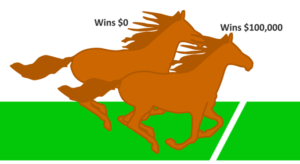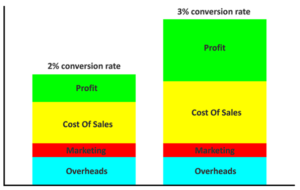The slight edge effect is a phenomenon that is known to be applicable in business and in a few other areas, but it is particularly appropriate for conversion rate optimization (and internet marketing in general in some ways).
In this post, I will briefly outline what it actually means and then we can look at how it applies to CRO and how you can use it to your advantage to blow your competition out of the water!
What Is It?
The slight edge effect refers to those times when being a little bit better produces a result that is much better. The most common example is in horse racing, as you’ll see below:

The horse who wins the race might only be a fraction of a second faster than the horse who comes second, but more often than not, the winning horse wins a substantially higher payout than the horse in second place.
In this situation we say that although the winning horse has a very slight edge, it takes a sizeable portion of the spoils.
In the world of online business, this effect means that often you only need to be a little bit better than your competition to take a big portion of the market share.
A Slight Edge In CRO
The great thing about conversion rate optimization is that it is a great way to gain an edge for a couple of reasons:
Firstly, your competition probably won’t be split testing, or at least not very well, because most business don’t do it.
Secondly, it’s really difficult for your competition to copy your winning strategy, because what works for your site might not work for theirs – so whilst you are winning more customers they won’t even know what you’re doing differently.
Profit Sensitivity
Most businesses have some fixed costs which don’t go up with sales, and chances are that you also spend money on marketing. When you improve your conversion rate, you make more sales (leads, revenue or whatever else) WITHOUT needing to increase your marketing spend.
So let’s say that you increase your conversion rate on sales from 2% to 3%. That doesn’t seem like a lot, but it means that you will be making 50% more sales… So let’s look at the numbers:

In this (very tacky) diagram you can see that when the conversion rate increases by 50% the total revenue increases by 50% too – that’s the total height of the columns.
You will also notice that the cost of sales increases by 50% but the other costs stay the same and the result is that the PROFITS increase by much more than 50%.
The exact results will vary of course, but in almost all cases, increasing your conversion rate on sales (or whatever your revenue generating metrics are) will increase your profits by a much larger factor.
Increasing Your Per Visitor Value
Another cool thing about this slight edge is that by increasing the chances that a visitor will buy a product you effectively increase the value of each visitor. Let’s take an example:
- Say you convert at 2% and your average sale is worth $50 in profit
- So out of 100 visitors you make 2 sales and a total profit of $100
- Which means that each visitor is worth $1 on average
Now let’s say that you increase your conversion rate to 3% by using some clever split testing and some well designed tests:
- At 3% conversion rate and still making $50 in profit on each sale
- You now make a total profit of $150 from 100 visitors
- Which means that on average each visitor is worth $1.50
Hopefully the benefit is obvious, but in case it’s not; if you happen to be using Adwords to drive traffic, you can now bid on any keyphrase up to a CPC of $1.49 and still make a profit.
This will almost certainly open a lot more opportunities to bring in more traffic which previously just wouldn’t have been profitable. Even better though, much of your competition won’t be able to bid as high because they won’t have optimized for conversions, which means that they can’t even try to compete with you on those keywords.
Of course this benefit isn’t limited to PPC (that’s just an easy example). When your traffic is worth more, you can (profitably) invest more in all types of marketing (SEO, regular advertising, even offline advertising) which means that you can scale your business faster.
What Should You Do With This Information?
Well the easy answer is start split testing, but if you’re still unsure (or you have a boss to convince) you can use this concept within your marketing strategy in order to forecast not only what you can do now but what you could do next.
For example, many businesses don’t use PPC because it is really hard to make a profit and if you don’t have a huge budget that’s a sticking point. But as an exercise:
- What is your current conversion rate?
- What is your average sale worth?
- What is the profit margin on that?
- What is the value of a single visitor?
Next, you can explore Adwords (and other PPC platforms) and find out what the cost per click is likely to be for various words and phrases.
Note:
There is plenty that you can do to reduce your CPC, but if you have a limited budget you probably need your PPC campaign to be profitable (or at least break even) from day 1.
Finally, rerun the numbers based on a modest performance improvement. Try with a conversion rate increase of 20%, 40% and 60% for instance.
Now see what level of traffic is available for the new CPC figures and you can estimate exactly how much you could grow you sales by if you were able to increase your conversion rates by those margins.
